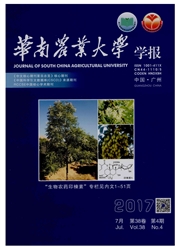

 中文摘要:
中文摘要:
选用4个籼型(杂交)水稻品种和1个地方糯稻品种,以不同品种组合及按不同行比种植进行田间控制水稻白叶枯病研究.结果表明,糯稻与籼型水稻品种间栽可有效地减轻水稻白叶枯病发生率和严重度,不同品种组合防病效果不同,混合间栽组合中黄壳糯效果较好,与其净栽模式相比,2005和2006年在糯稻品种上白叶枯病的最高防效分别达52.0%和86.4%,在主栽籼稻品种上白叶枯病的最高防效分别为59.3%和66.6%;以黄壳糯作为间栽品种时,可有效降低病害传播距离,与净栽相比,间栽种植水稻自叶枯病传播距离降低了21.8%~59.2%;同一品种组合、不同行比的间栽模式防治水稻白叶枯病效果不同,混合间栽的主栽品种和间栽品种之间存在着一定的配比关系,其中以主栽品种与间栽品种按6:1行比种植,对病害的控制效果最好.
 英文摘要:
英文摘要:
Field experiments of the mixed-and pure-planting of five rice varieties, representing four indica or hybrid varieties and one glutinous rice variety, were conducted to determine the effects of different rice varieties planting combinations and their deployment mode on controlling baeterial blight (BB) of rice. The results demonstrated that mixed-planting of glutinous and indica rice varieties had a greater effect on reducing the incidence and severity of rice BB than the pure-planting of these varieties, particularly for glutinous cv. Huangkenuo, with maximum control efficiencies of 52% and 86. 4% , while 59.3% and 66.6% on indica rice varieties in mixed-planting compared with their pure-planting in 2005 and 2006, respectively. Meanwhile, different planting combinations of rice varieties showed a different control efficiency against the rice BB. The distance of the rice BB progressed in different mixed-planting plots was reduced by 21.8% -59.2% compared with the pure-planting plots. It was showed that the ratio between glutinous and indica rice variety cultured in mixed-planting plots also affected the control efficiency against the rice BB, the best ratio for cultivation between glutinous and indiea rice cultivar was 1 row: 6 rows, which would provide the best control efficiency for rice BB.
 同期刊论文项目
同期刊论文项目
 同项目期刊论文
同项目期刊论文
 期刊信息
期刊信息
